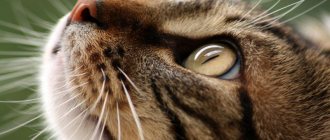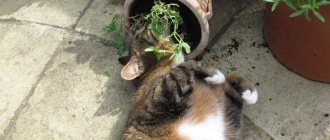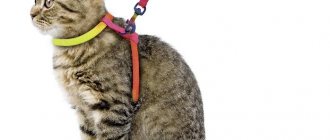Meaning of mustache
At the base of the cat's whiskers are muscles containing nerve endings. Each of them is connected in a certain way to the brain. At the slightest vibrations of the whiskers (vibrissae), the necessary information is transmitted at the impulse level. Scientists have found that through these hairs, representatives of the cat family have a three-dimensional specific vision of the world around them in the dark.
Table No. 1. The importance of mustaches and eyebrows for cats
| Function | Meaning |
| Communicative | Vibrissae are a way of transmitting an emotional background. If the hairs are pressed closely to the base of the muzzle, then she does not want to make any contact. Antennae that stick out in all directions signal that the animal is ready to play and frolic. |
| Tactical | Thanks to their high tactile properties, whiskers and eyebrows help the cat to correctly identify the location of the enemy and instantly build strategic, error-free actions. |
| Compensatory | There is a significant disadvantage among felines. The lower half of the muzzle belongs to the blind spot; they absolutely cannot see objects that are located below. The mustache made it possible to compensate for this omission of nature |
| Navigational | With the help of its whiskers, a cat, even a blind one, can navigate the surrounding space and receive maximum information about the objects around it. She feels the thickening of the air next to the object and even with limited visibility she senses it on an instinctive level |
| Meteorological | Thanks to the hairs on their faces, pets receive information about electromagnetic changes in the earth's biofield. By their behavior you can learn about the weather for the near future. |
| Recognition | Before eating any food, the cat will feel it with its whiskers and only then begin to eat. |
| Measuring | Through whiskers, the animal determines the size of objects and objects. Where to climb, how to climb, from what height you need to jump - all this is determined in this way |
It is known that pets can obtain information about objects using fur and skin. To gain confidence in complete safety, they begin to act only after using the mustache. This is a kind of strategic behavior, an additional defensive reaction.
As a result of research, it was revealed that whiskers appeared in the ancestors of the cat family long before their hair began to grow. This evolutionary theory suggests that whiskers are one of the main distinguishing features of these mammals.
It is the whiskers that are especially sensitive to negative electrical discharges generated when stroking a cat against the grain. A distinctive characteristic of the hairs located on the muzzle is that they help the animal navigate in nearby space. Thus, being the main coordinators of movements, whiskers are simply vital for pets.
Main functions
A cat's whiskers, otherwise called whiskers, are the most important organ of touch. Through the nerve endings located on them, the received information enters the brain.
They perform the following functions:
- Helps to navigate in space. Everyone knows that cats move without bumping into objects even in complete darkness. In this they are helped not only by their visual organs, but also by their whiskers, which allow them to determine the size and distance to objects. Thanks to the vibrissae, they reliably understand whether they can pass through a small opening or not.
- Food analysis. In addition to the sense of smell and mouth, vibrissae are also involved in assessing the properties of food: its freshness, taste, temperature and safety.
- For hunting. They allow you to detect the slightest movements of the victim, even if it is very far away. They also make it clear whether the potential victim is alive or not.
- For communication. The disposition to communicate can be seen by their location. If the cat is irritated and does not want to be touched, then he will press them to his face. Fluffy, twitching and sticking out always signal readiness for games and a good mood.
Main functions of the mustache
Why you can't trim your mustache and eyebrows
Trimming a cat's whiskers and eyebrows is strictly contraindicated. This makes their existence very difficult. Vibrissae are one of the main organs of the cat family and serve as tactile and olfactory receptors. In some animals, the hairs may fall off on their own for a variety of reasons, but then they grow back. However, specially cut hairs cause significant discomfort to the pet.
Cats should not have their hair cut because it will negatively affect their health. The pet will not lose its sense of touch or smell, but spatial orientation will deteriorate significantly. Instead of lost or cut whiskers, new ones will grow in the cat only after 3 months. This is a very long period of time, so cats should not have their whiskers trimmed.
Damaged whiskers deprive the cat of adequate perception of the surrounding world
What problems will a cat have to face if its whiskers are trimmed?
- there is a decrease in jumping ability as a result of a deterioration in the computational function, the pet jumps or does not jump to the desired goal;
- there is a loss of the ability to accurately measure objects or distances, the cat may suddenly get stuck or fall;
- changes in behavior are observed, the animal becomes inactive, timid, and sometimes aggressive;
- the risks of injury increase, for example, a cat may lose an eye or injure its skin without noticing the threat in time due to the lack of whiskers;
- a certain disorientation develops, due to which the animal is often injured at night, gets hit by cars, and is unable to escape from the dog in time.
In most cases, while the cat's cut hairs grow back, she leads a recumbent lifestyle and loses her appetite. As a result, the fur becomes faded and loses its color. The pet stops catching mice, does not react to birds and live fish, and begins to go to the toilet in the wrong places.
Vibrissae and cat facial expressions
Vibrissae are also a mimic organ
But that's not all! Vibrissae are also a cat’s facial instrument, and depending on their position, we can even know exactly what our cat is feeling at the moment.
So, if a cat's whiskers are turned forward, the cat is in a state of interest, or wants to scare its rival and opponent with its belligerent appearance. If the cat’s whiskers are directed back, this means that the cat is internally compressed and is in a state of anxiety...
From all that has been said above, it becomes clear that the animal needs a cat’s whiskers and eyebrows not for decoration, but for specific functions. Accordingly, when the whiskers suffer (the cat singed them, or your baby decided to give her a new hairstyle), the cat not only changes in appearance, it is deprived of the opportunity to use one of its senses and facial expressions. You won't believe it, but
veterinarians note in cats that, due to various life circumstances, have lost their whiskers, signs of a real neuropsychic disorder, since the animal loses not only its whiskers and eyebrows, it loses the ability to receive and process a huge flow of information that is important to it. Finding herself so defenseless, your pet begins to behave inappropriately, and you notice strange behavior in your cat.
How to help a pet who has lost its whiskers
There are no specially designed drugs or products to accelerate the growth of whiskers in cats. With a healthy hair follicle, the vibrissae grow on their own. There is no need for additional care. Veterinarians emphasize that there is no need to use any ointments or creams, this will not bring any benefit.
If it happens that your mustache breaks or falls off, you need to diversify your diet. It is advisable to include the following products in your daily menu:
- cottage cheese;
- vegetable oil;
- milk.
Already in the 3rd week, the hairs grow a couple of millimeters, which allows the four-legged pet to again adequately respond to the world around it. Over the next 4-10 weeks, the vibrissae acquire the required size, and their receptors are completely restored.
Necessity of whiskers for cats
Cats use their whiskers to measure the size of objects. For example, by touching the walls of a hole with its whiskers, a cat can immediately determine whether it will fit through this hole. Whiskers allow cats to determine the location of objects and avoid obstacles in complete darkness. Vibrissae are indispensable for a cat when hunting; with their help, he determines the direction and speed of the wind to make the most accurate jump. With the help of its whiskers, the animal controls the prey when it holds it in its teeth.
Damaged cat whiskers will grow back within a few weeks.
Vibrissae on the paws help the cat sense vibrations in the floor. Eyebrow vibrissae protect the eyes, allowing the eyelids to close in a timely manner. A cat's whiskers are indicators of an animal's mood. In an excited or interested cat, they are directed forward and widely spaced.
If the cat is scared or angry, he presses his whiskers to his muzzle.
The average length of a cat's whiskers is 6-7 cm. Maine Coon cats have the longest whiskers. The length of the mustache of a Maine Coon named Missy (Finland), amounting to 19 centimeters, was listed in the Guinness Book of Records. The whiskers of cats are very sensitive, so animals do not like to be touched.
Whiskers should not be trimmed; cats without them become confused and their movements become uncertain. Frequent loss of a large number of mustaches can be caused by poor diet, deficiency of vitamins and minerals, or be a symptom of a disease. In such cases, it is advisable to consult a veterinarian.
How do whiskers differ between cats and cats?
There are no distinctive features in the location and structure of the whiskers of cats and kittens. There are no gender differences, and the vibrissae are responsible for the same functions. Each animal can have a certain thickness and length individually. This feature is considered strictly genetic.
The size of the hairs depends primarily on how fortified and balanced the pet’s diet will be. Our ancestors believed that the length of the whiskers of pets was influenced by the number of mice caught. It is not without scientific basis, because it is thanks to hunting that cats constantly train their ability to concentrate and react quickly.
If someone has never wondered why a cat needs a mustache, he will now understand that this is the most necessary organ of smell. Thanks to vibrissae, pets are the most careful and most successful hunters. All the most important receptors are located on the whiskers, thanks to which animals can exist normally. The loss of hairs deprives them of the ability to quickly find food and avoid an attack in time.
- Author: Olga
Rate this article:
- 5
- 4
- 3
- 2
- 1
(4 votes, average: 4 out of 5)
Share with your friends!
What causes vibrissae to fall out?
It also happens that owners have never tried to cut their pet’s mustache, but still notice that there are much fewer coarse hairs on the face or they are constantly breaking off. In this case, pet owners have a question about why their cat’s whiskers are falling out. Loss of vibrissae occurs for the following reasons:
- vitamin deficiency (with a lack of important vitamins, the animal can lose not only its fur, but also its whiskers);
- self-renewal (like any hair, the mustache can be renewed throughout life; new ones usually immediately grow in place of old whiskers);
- age (with the onset of old age, the pet may lose part of its antennae);
- diseases (some cat diseases provoke loss of whiskers; also, in sick pets, long whiskers often break and split);
- mechanical damage (after a fight or a fun game with another animal, a cat’s antennae may fall out).
Observing the behavior of a recently lambed female, owners often ask themselves another curious question: why does a cat chew off the kittens’ whiskers? It is not known for certain, but most often such a strange action can be explained as follows: the mother cat is trying to protect her cubs from unnecessary movements in space. Without antennae, kittens will not be able to crawl far, and therefore will not expose themselves to any serious danger.
Having noticed that the pet's whiskers have broken off or fallen off, the owner does not need to immediately panic. First of all, you need to try to independently determine the reason why the antennae break. If any ailments occur, the cat should be shown to a doctor. The specialist will make a diagnosis and tell you what to do so that the mustache recovers as quickly as possible.
Sense organ
We have learned since childhood that a person has developed 5 senses, which correspond to a certain part of the body. The animals are luckier. To the standard sense organs, an additional one is added, which is very important - the mustache. Not many people know what a cat's whiskers are called. Experts gave them a definition - vibrissae. The word comes from the Latin name vibrissae, which means “vibration”.
Whiskers are long hairs located near the animal's nose. They are quite rigid, but can break off. If the animal's fur provides thermal insulation, then the additional sense organ is directly connected to the nervous system and performs a tactile function.











